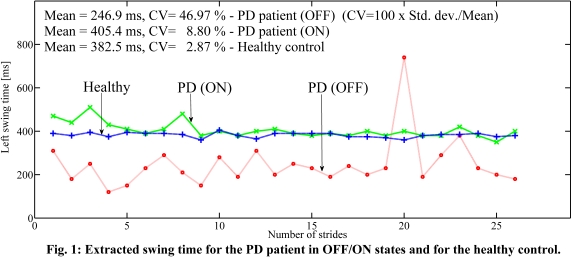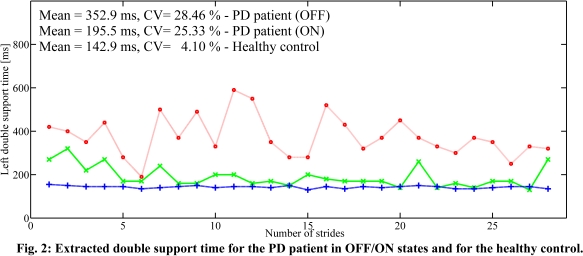Session Information
Date: Tuesday, June 21, 2016
Session Title: Technology
Session Time: 12:30pm-2:00pm
Location: Exhibit Hall located in Hall B, Level 2
Objective: To perform a proof-of-concept study showing the utility of versatile algorithms aimed at objectively quantifying the duration of refined gait features during ambulatory walking in a patient with Parkinson’s disease (PD) in OFF/ON medication states as compared with an age-matched control subject.
Background: Gait features in PD are characterized by spatial and temporal pattern disturbances. In clinical practice, these are usually assessed visually on a short walking trial using subjective scales such the Unified Parkinson’s disease Rating Scale (UPDRS). This has obvious limitations including subjectivity and inter-rater variability. To address this issue, we recently developed and validated an accelerometer-based system to quantify gait features during ambulatory walking [1].
Methods: We recorded acceleration signals in a healthy control (male; age=67 years; height=1.72 m; weight=90 kg), with no history of gait abnormalities, and in a PD patient (female; age=69 years; height=1.68 m; weight=58 kg; disease duration=22 years) in OFF (18 hours off medication) and ON (under usual medications) states. Gait signals were obtained as subjects walked back and forth on a 15 m long straight walkway for 1 to 2 min, at their usual speed using an ambulatory system that included four synchronized accelerometers attached directly to the subject’s regular shoes at the level of the (right/left) heels and toes. We developed versatile algorithms [1] to extract durations of (1) stance and stance sub-phases (i.e., loading response, mid-stance, and push-off), (2) swing, and (3) double support. Here we report data on swing and double support times.
Results: The experimental results are shown in Figs. 1-2 
 .
.
Conclusions: Our data show that our algorithms provide relevant gait parameters that can discriminate between a PD patient in OFF/ON states and a healthy control. To the best of our knowledge, this is also one of the first demonstrations that refined temporal gait features to be quantified outside a laboratory/hospital setting. The proposed algorithms are now being used to analyze the gait of a larger set of subjects including controls and PD patients to confirm the relevance of these refined gait parameters. References: [1] Boutaayamou, M., et al. Development and validation of an accelerometer-based method for quantifying gait events. Medical Engineering and Physics, 37, 226–232, 2015.
To cite this abstract in AMA style:
M. Boutaayamou, M. Demonceau, O. Brüls, J.G. Verly, G. Garraux. Analysis of temporal gait features extracted from accelerometer-based signals during ambulatory walking in Parkinson’s disease [abstract]. Mov Disord. 2016; 31 (suppl 2). https://www.mdsabstracts.org/abstract/analysis-of-temporal-gait-features-extracted-from-accelerometer-based-signals-during-ambulatory-walking-in-parkinsons-disease/. Accessed April 2, 2025.« Back to 2016 International Congress
MDS Abstracts - https://www.mdsabstracts.org/abstract/analysis-of-temporal-gait-features-extracted-from-accelerometer-based-signals-during-ambulatory-walking-in-parkinsons-disease/
